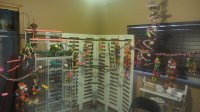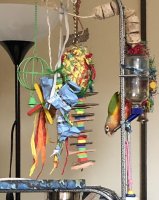My Parrot Won’t Play With Toys!
This is a claim I hear often from parrot owners who are totally frustrated in their efforts to offer enrichment in the form of toys or foraging, only to see their birds ignoring it. Many simply give up, after spending what seems like endless amounts of time and money, having achieved no success at all.
And, after all… isn’t it okay if we have a bird who doesn’t play with toys if he seems happy enough? If he’s not displaying behavior problems and he’s healthy, why keep trying? Keeping parrots seems to be a lot of work at times. Many ask, “Do I really need to keep working on this too?”
I hate to disappoint you…but the answer is yes.
 You do need to keep working on this. Your parrot does need to interact with enrichment for the very best quality of life. If you want him to enjoy physical, emotional, and intellectual health, you’ve got to keep trying.
You do need to keep working on this. Your parrot does need to interact with enrichment for the very best quality of life. If you want him to enjoy physical, emotional, and intellectual health, you’ve got to keep trying.
Parrots, like all creatures, evolved to act upon their environment in different ways. When they do, the environment gives them feedback. This feedback from the environment offers them the chance to learn. This learning process enriches their lives much of the time in different ways.
A parrot who doesn’t know how to keep himself busy is a lot more likely to develop behavior problems such as screaming or chewing off feathers. “Captive settings may limit the expression of normal behaviours and, as a consequence, abnormal behaviours may develop.” (Rodriguez-Lopez, 2016)
 Your parrot can work on a foraging project for 30 minutes, finally accessing his treat. Or he can scream for 30 minutes until you finally react. The treat and your reaction are both “feedback” from the environment. Both types of feedback enrich his life because he acted on the environment in order to get a certain result.
Your parrot can work on a foraging project for 30 minutes, finally accessing his treat. Or he can scream for 30 minutes until you finally react. The treat and your reaction are both “feedback” from the environment. Both types of feedback enrich his life because he acted on the environment in order to get a certain result.
His existence is enriched by your social attention when you react, even if you sound angry or use a swear word or two. It can be quite enjoyable for a bored parrot to figure out what he can do to get a reaction out of you. He is hard-wired to act upon his environment. He will do so independently of you and your desires.
I have always thought of a parrot’s day as similar to a “pie chart of activity.” In other words, they operate in our homes within an “activity budget.” I want my parrots’ activity budget to look something like this pie graph. Granted, the time spent in each activity likely would not be the same, but you get the idea.

If your parrot doesn’t fly or interact with wood or other enrichment, there’s a much greater chance that some of those pie wedges may read “screaming” or “biting” or “feather destruction.”
There is a second reason why we can’t give up on trying to get our parrots to interact with physical enrichment. Life in captivity is stressful for our companion parrots, no matter how good a job we do with them. “Captive animals are susceptible to chronic stress due to restricted space, lack of hiding places, presence of visitors, or the lack of resources that promote physical and mental stimuli. In birds, chronic stress can promote stereotypes, self-mutilation, feather picking, chewing on cage bars and walls, fearfulness and excessive aggression. Environmental enrichment (EE) becomes an important management tool to decrease chronic stress in captive animals.” (de Almeida, Palme, and Moreira 2018)
Thus, it is a real problem when a parrot doesn’t interact with enrichment or know how to forage. It’s enough of a problem that it deserves dissection. If we can come to a better understanding of the problem, we can both prevent it AND solve it.
The problem begins with our own expectations. Everyone talks about parrots “playing,” so we expect our parrots to play. This expectation is not a reasonable one, if applied to all parrots.
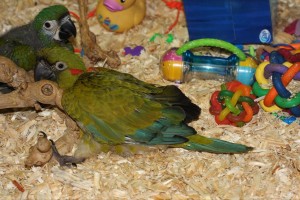 Baby parrots play. One of the happiest periods of my life was when I was breeding a small number of African Greys each year. There is nothing more fun that watching the development of baby parrots. They are learning machines. They are eager to investigate anything you give them. Like all baby animals, they are playful. That is their job – it’s how they learn about the world.
Baby parrots play. One of the happiest periods of my life was when I was breeding a small number of African Greys each year. There is nothing more fun that watching the development of baby parrots. They are learning machines. They are eager to investigate anything you give them. Like all baby animals, they are playful. That is their job – it’s how they learn about the world.
Once mature, however, most adult parrots don’t play. It’s not their nature to be playful. Granted, there are exceptions. Some individuals are more playful than others. Some species tend to be more playful than others – caiques, lorikeets, small macaws and some conures, to name a few. Some individuals within those species could play for hours with a simple object. If you need cheering up, check this video out.
However, if you expect an African Grey, one of the Poicephalus species, or an Eclectus to be playful, you could wait a very long time. Thus, the first problem is thinking there is something wrong with your parrot if he doesn’t play.
An adult parrot has a different job – to stay safe with the knowledge he’s learned to date. They are often suspicious, if not downright afraid, of new things. If you expect your adult parrot to immediately interact with a new toy or project, you may be sadly disappointed. It could very well take a week or longer before your bird decides that object is safe enough for exploration. So, that’s the second problem – expecting your parrot to interact with new enrichment items without a proper period of introduction.
If your older parrot was raised by a breeder who didn’t offer enrichment to the babies and then went into a first home or two where this need was also neglected, he may have temporarily lost that once-important desire to investigate, even once an item does become familiar. Both situations can lead to that diagnosis – My parrot doesn’t play with toys!
The third problem we create for ourselves with this issue has to do with perception. Dr. Susan Friedman has made enormous contributions to our understanding of behavior. In many of her articles, she discusses the problems that result when we label parrot behavior. For example, if I think of my parrot as aggressive, this leads me nowhere, in terms of arriving at a solution to that problem. However, if I look at the circumstances surrounding the bites, I see that there are some things I can change. Changing the right circumstances in an effective way does lead to a solution to the problem.
When you tell yourself …My parrot doesn’t play with toys!…it’s the same thing as imposing a label on your parrot.
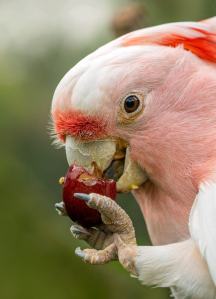 That statement in itself will prevent you from solving this problem because you will believe it. To move toward a solution, you must look at what the parrot does do and build from there. Every parrot interacts with some objects, even if you don’t think of them as toys.
That statement in itself will prevent you from solving this problem because you will believe it. To move toward a solution, you must look at what the parrot does do and build from there. Every parrot interacts with some objects, even if you don’t think of them as toys.
A fourth obstacle to having a parrot who interacts with enrichment is the type of things manufactured and sold to parrot owners. Often these are targeted at you and your pocketbook, rather than your parrot’s preferences. Purchasing the wrong type of toys can lead to the same conclusion – My parrot doesn’t play with toys!
For one thing, the desires of a parrot and the desires of a parrot owner are not the same and toy manufacturers know this. A parrot wants to destroy a wood toy quickly and easily. He wants to act on his environment. A parrot owner wants to buy a toy that will last due to the expense. He wants to spend his money wisely.

How many of us have wasted our money on the toy to the right? Those alphabet blocks and round wooden beads are so hard that only the very largest of parrots can chew them up. Most parrots will simply give up after a short while. But, the important thing to the owner is that he didn’t spend $25.00 on a toy that only lasted a brief while.
The second problem is the power of advertising. We love parrots and we love photos of parrots. Therefore, as a selling tool the manufacturer or company will position a toy with a parrot suggesting interest in the parrot towards the toy.
 You’ve got to use your critical thinking skills to question the advertising before moving the item into your shopping cart. Look at the toy to the left. Suggested by the photo as appropriate for a cockatiel, this toy is totally unsatisfactory for a bird of that size…or any bird. Those coconuts are very hard and the holes are so small that getting anything out of them would be difficult.
You’ve got to use your critical thinking skills to question the advertising before moving the item into your shopping cart. Look at the toy to the left. Suggested by the photo as appropriate for a cockatiel, this toy is totally unsatisfactory for a bird of that size…or any bird. Those coconuts are very hard and the holes are so small that getting anything out of them would be difficult.
Let the buyer beware.
So, what are you supposed to do if you have a bird doesn’t play with toys?
First, find a starting place. Most parrots interact with something. If you have a parrot who loves to play with bottle caps (and doesn’t chew on them), hide bottle caps in a foraging toy so that it takes some work for him to get at them.
If your parrot loves to chew the back of your sofa, create toys made of fabric. Get a cotton gardening glove and stuff it with interesting items and food treats and hang this in the cage. Or find a pair of baby overalls at Goodwill and use zip ties to close up the legs. Then, stuff the pockets with foot toys and treats.
If your parrot loves paper and cardboard, but won’t chew wood, then give him foraging projects made from those materials. If your parrot only chews on smaller wood toys, but demolishes them too quickly, then create these with wood slices and beads on a stainless skewer sold for parrots.
Second, make sure that the perching you provide sets the bird up for success and makes it easy for him to interact with the item. I often see toys hung in the cage without any perch nearby. Put yourself in your parrot’s feathers. If he perches there, can he reach that toy comfortably?
Third, provide reinforcement. Once you have found an item with which your parrot interacts, keep a soft focus on his behavior. When you see him touch or chew the toy…or even just look at it…immediately tell him “Good!” and quickly offer a preferred food treat. Soon he will learn that messing around with things in his cage earns him food!
Fourth, experiment. Gradually, add a wider variety of toys – stainless steel bells, paper, fabric, easy-to-chew wood, puzzle toys, etc. Through this process, you can discover a lot about your bird. Don’t pre-judge his interests and preferences. Perhaps you’ve always just given him wood toys, only to find that he’s insane for bells. Many small macaws for example, enjoy sitting underneath bells. One caveat: most parrots prefer toys made of natural materials; my advice would be to leave those acrylic toys at the bird store, unless they offer a foraging challenge.
One small study found that parrots interacted with their staple diet of pellets for longer periods if they were provided with “over-sized” pellets. (Rozek, Danner, Stucky, Millam, 2010) These required longer periods of time for consumption, given the additional challenges of manipulation. If your parrot consumes one size of pellet, perhaps providing much larger pellets in or out of foraging toys could be an important type of enrichment.
The most difficult challenge can be teaching an older parrot to forage who never learned the skill in the first place. Baby parrots are naturally curious, but they have to be provided with the raw materials to develop this into the skill of exploration. Older parrots can still learn this, however, and it is important that they do. “Enrichment is more successful it if is aimed at soliciting species-specific behaviours such as foraging.” (Coulton, Waran, Young, 1997)
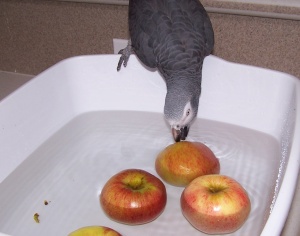 Teaching a parrot to forage requires starting with very basic challenges and then making them incrementally more difficult in small steps. Many of you may have already seen this, either on my website or on Facebook, but I have completed a pamphlet of foraging challenges that are easily made at home from inexpensive materials. It demonstrates how to start out simple and gradually add complexity. This is free to all of you for download: Parrot Enrichment Made Easy: Low Cost Tips and Tricks.
Teaching a parrot to forage requires starting with very basic challenges and then making them incrementally more difficult in small steps. Many of you may have already seen this, either on my website or on Facebook, but I have completed a pamphlet of foraging challenges that are easily made at home from inexpensive materials. It demonstrates how to start out simple and gradually add complexity. This is free to all of you for download: Parrot Enrichment Made Easy: Low Cost Tips and Tricks.
Lastly, there are some foraging toys sold on the market today that do help beginning foragers to learn the skill. My favorite is the Acrylic Foraging Kabob. It triggers interest because the parrot can see that it has something inside of it, but offers enough of a challenge in extracting the items. It can be very helpful in introducing vegetables. And, it includes a food skewer that is useful in making other toys.
A last word. Remember – always watch your parrot with any new toy to make sure he’s interacting with it safely. Most parrots will not ingest non-food items, but watch nonetheless, especially if you are giving your parrot a toy with cotton strings attached.
End Note: I attempt, whenever possible, to substantiate my anecdotal observations with scientific research. I have cited a number of studies at the end of this blog that help to support what I have said. However, there has been a bit of a bias among researchers to focus more on enrichment for captive primates and carnivores. The studies that have been performed for captive parrots are few and often have been done on very small populations. They may be suggestive, rather than definitive.
Thank you for reading my blog. I am Pamela Clark, an IAABC Certified Parrot Behavior Consultant and licensed veterinary technician. My passion is helping people with parrots. For more information and to access many free resources, please visit me at http://www.pamelaclarkonline.com. Until next time!
Please note: Credit for the featured photo goes to Saeed Lajami on Unsplash.com.
References:
Coulton, LE, NK Waran, and RJ Young. 1997. “Effects of Foraging Enrichment on the Behaviour of Parrots.” Animal Welfare 1997, 6: 357-363. https://www.researchgate.net/profil...of_Parrots/links/004635388f928d5693000000.pdf
De Almeida, Ana Claudia, Rupert Palm and Nei Moreira. 2018. “How Environmental Enrichment Affects Behavioral and Glucocorticoid Responses in Captive Blue-and-Yellow Macaws (Ara araruana).” Elsevior Applied Animal Behavior Science Journal 201: 125-135. Redirecting
Meehan, CL, JP Garner, and JA Mench. 2004. “Environmental Enrichment and Development of Cage Stereotypy in Orange-winged Amazons (Amazona amazonica). Wiley Periodicals, Inc. Dev Psychogiol 44: 209-218. https://pdfs.semanticscholar.org/bbb2/a21684e23a62de973c1779e8d6a103f7463a.pdf
Published by
This is a claim I hear often from parrot owners who are totally frustrated in their efforts to offer enrichment in the form of toys or foraging, only to see their birds ignoring it. Many simply give up, after spending what seems like endless amounts of time and money, having achieved no success at all.
And, after all… isn’t it okay if we have a bird who doesn’t play with toys if he seems happy enough? If he’s not displaying behavior problems and he’s healthy, why keep trying? Keeping parrots seems to be a lot of work at times. Many ask, “Do I really need to keep working on this too?”
I hate to disappoint you…but the answer is yes.

Parrots, like all creatures, evolved to act upon their environment in different ways. When they do, the environment gives them feedback. This feedback from the environment offers them the chance to learn. This learning process enriches their lives much of the time in different ways.
A parrot who doesn’t know how to keep himself busy is a lot more likely to develop behavior problems such as screaming or chewing off feathers. “Captive settings may limit the expression of normal behaviours and, as a consequence, abnormal behaviours may develop.” (Rodriguez-Lopez, 2016)

His existence is enriched by your social attention when you react, even if you sound angry or use a swear word or two. It can be quite enjoyable for a bored parrot to figure out what he can do to get a reaction out of you. He is hard-wired to act upon his environment. He will do so independently of you and your desires.
I have always thought of a parrot’s day as similar to a “pie chart of activity.” In other words, they operate in our homes within an “activity budget.” I want my parrots’ activity budget to look something like this pie graph. Granted, the time spent in each activity likely would not be the same, but you get the idea.

If your parrot doesn’t fly or interact with wood or other enrichment, there’s a much greater chance that some of those pie wedges may read “screaming” or “biting” or “feather destruction.”
There is a second reason why we can’t give up on trying to get our parrots to interact with physical enrichment. Life in captivity is stressful for our companion parrots, no matter how good a job we do with them. “Captive animals are susceptible to chronic stress due to restricted space, lack of hiding places, presence of visitors, or the lack of resources that promote physical and mental stimuli. In birds, chronic stress can promote stereotypes, self-mutilation, feather picking, chewing on cage bars and walls, fearfulness and excessive aggression. Environmental enrichment (EE) becomes an important management tool to decrease chronic stress in captive animals.” (de Almeida, Palme, and Moreira 2018)
Thus, it is a real problem when a parrot doesn’t interact with enrichment or know how to forage. It’s enough of a problem that it deserves dissection. If we can come to a better understanding of the problem, we can both prevent it AND solve it.
The problem begins with our own expectations. Everyone talks about parrots “playing,” so we expect our parrots to play. This expectation is not a reasonable one, if applied to all parrots.

Once mature, however, most adult parrots don’t play. It’s not their nature to be playful. Granted, there are exceptions. Some individuals are more playful than others. Some species tend to be more playful than others – caiques, lorikeets, small macaws and some conures, to name a few. Some individuals within those species could play for hours with a simple object. If you need cheering up, check this video out.
However, if you expect an African Grey, one of the Poicephalus species, or an Eclectus to be playful, you could wait a very long time. Thus, the first problem is thinking there is something wrong with your parrot if he doesn’t play.
An adult parrot has a different job – to stay safe with the knowledge he’s learned to date. They are often suspicious, if not downright afraid, of new things. If you expect your adult parrot to immediately interact with a new toy or project, you may be sadly disappointed. It could very well take a week or longer before your bird decides that object is safe enough for exploration. So, that’s the second problem – expecting your parrot to interact with new enrichment items without a proper period of introduction.
If your older parrot was raised by a breeder who didn’t offer enrichment to the babies and then went into a first home or two where this need was also neglected, he may have temporarily lost that once-important desire to investigate, even once an item does become familiar. Both situations can lead to that diagnosis – My parrot doesn’t play with toys!
The third problem we create for ourselves with this issue has to do with perception. Dr. Susan Friedman has made enormous contributions to our understanding of behavior. In many of her articles, she discusses the problems that result when we label parrot behavior. For example, if I think of my parrot as aggressive, this leads me nowhere, in terms of arriving at a solution to that problem. However, if I look at the circumstances surrounding the bites, I see that there are some things I can change. Changing the right circumstances in an effective way does lead to a solution to the problem.
When you tell yourself …My parrot doesn’t play with toys!…it’s the same thing as imposing a label on your parrot.

A fourth obstacle to having a parrot who interacts with enrichment is the type of things manufactured and sold to parrot owners. Often these are targeted at you and your pocketbook, rather than your parrot’s preferences. Purchasing the wrong type of toys can lead to the same conclusion – My parrot doesn’t play with toys!
For one thing, the desires of a parrot and the desires of a parrot owner are not the same and toy manufacturers know this. A parrot wants to destroy a wood toy quickly and easily. He wants to act on his environment. A parrot owner wants to buy a toy that will last due to the expense. He wants to spend his money wisely.

How many of us have wasted our money on the toy to the right? Those alphabet blocks and round wooden beads are so hard that only the very largest of parrots can chew them up. Most parrots will simply give up after a short while. But, the important thing to the owner is that he didn’t spend $25.00 on a toy that only lasted a brief while.
The second problem is the power of advertising. We love parrots and we love photos of parrots. Therefore, as a selling tool the manufacturer or company will position a toy with a parrot suggesting interest in the parrot towards the toy.

Let the buyer beware.
So, what are you supposed to do if you have a bird doesn’t play with toys?
First, find a starting place. Most parrots interact with something. If you have a parrot who loves to play with bottle caps (and doesn’t chew on them), hide bottle caps in a foraging toy so that it takes some work for him to get at them.
If your parrot loves to chew the back of your sofa, create toys made of fabric. Get a cotton gardening glove and stuff it with interesting items and food treats and hang this in the cage. Or find a pair of baby overalls at Goodwill and use zip ties to close up the legs. Then, stuff the pockets with foot toys and treats.
If your parrot loves paper and cardboard, but won’t chew wood, then give him foraging projects made from those materials. If your parrot only chews on smaller wood toys, but demolishes them too quickly, then create these with wood slices and beads on a stainless skewer sold for parrots.
Second, make sure that the perching you provide sets the bird up for success and makes it easy for him to interact with the item. I often see toys hung in the cage without any perch nearby. Put yourself in your parrot’s feathers. If he perches there, can he reach that toy comfortably?
Third, provide reinforcement. Once you have found an item with which your parrot interacts, keep a soft focus on his behavior. When you see him touch or chew the toy…or even just look at it…immediately tell him “Good!” and quickly offer a preferred food treat. Soon he will learn that messing around with things in his cage earns him food!
Fourth, experiment. Gradually, add a wider variety of toys – stainless steel bells, paper, fabric, easy-to-chew wood, puzzle toys, etc. Through this process, you can discover a lot about your bird. Don’t pre-judge his interests and preferences. Perhaps you’ve always just given him wood toys, only to find that he’s insane for bells. Many small macaws for example, enjoy sitting underneath bells. One caveat: most parrots prefer toys made of natural materials; my advice would be to leave those acrylic toys at the bird store, unless they offer a foraging challenge.
One small study found that parrots interacted with their staple diet of pellets for longer periods if they were provided with “over-sized” pellets. (Rozek, Danner, Stucky, Millam, 2010) These required longer periods of time for consumption, given the additional challenges of manipulation. If your parrot consumes one size of pellet, perhaps providing much larger pellets in or out of foraging toys could be an important type of enrichment.
The most difficult challenge can be teaching an older parrot to forage who never learned the skill in the first place. Baby parrots are naturally curious, but they have to be provided with the raw materials to develop this into the skill of exploration. Older parrots can still learn this, however, and it is important that they do. “Enrichment is more successful it if is aimed at soliciting species-specific behaviours such as foraging.” (Coulton, Waran, Young, 1997)

Lastly, there are some foraging toys sold on the market today that do help beginning foragers to learn the skill. My favorite is the Acrylic Foraging Kabob. It triggers interest because the parrot can see that it has something inside of it, but offers enough of a challenge in extracting the items. It can be very helpful in introducing vegetables. And, it includes a food skewer that is useful in making other toys.
A last word. Remember – always watch your parrot with any new toy to make sure he’s interacting with it safely. Most parrots will not ingest non-food items, but watch nonetheless, especially if you are giving your parrot a toy with cotton strings attached.
End Note: I attempt, whenever possible, to substantiate my anecdotal observations with scientific research. I have cited a number of studies at the end of this blog that help to support what I have said. However, there has been a bit of a bias among researchers to focus more on enrichment for captive primates and carnivores. The studies that have been performed for captive parrots are few and often have been done on very small populations. They may be suggestive, rather than definitive.
Thank you for reading my blog. I am Pamela Clark, an IAABC Certified Parrot Behavior Consultant and licensed veterinary technician. My passion is helping people with parrots. For more information and to access many free resources, please visit me at http://www.pamelaclarkonline.com. Until next time!
Please note: Credit for the featured photo goes to Saeed Lajami on Unsplash.com.
References:
Coulton, LE, NK Waran, and RJ Young. 1997. “Effects of Foraging Enrichment on the Behaviour of Parrots.” Animal Welfare 1997, 6: 357-363. https://www.researchgate.net/profil...of_Parrots/links/004635388f928d5693000000.pdf
De Almeida, Ana Claudia, Rupert Palm and Nei Moreira. 2018. “How Environmental Enrichment Affects Behavioral and Glucocorticoid Responses in Captive Blue-and-Yellow Macaws (Ara araruana).” Elsevior Applied Animal Behavior Science Journal 201: 125-135. Redirecting
Meehan, CL, JP Garner, and JA Mench. 2004. “Environmental Enrichment and Development of Cage Stereotypy in Orange-winged Amazons (Amazona amazonica). Wiley Periodicals, Inc. Dev Psychogiol 44: 209-218. https://pdfs.semanticscholar.org/bbb2/a21684e23a62de973c1779e8d6a103f7463a.pdf
Published by


